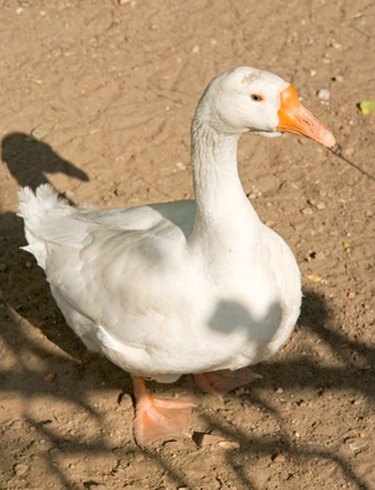
One Mother Goose nursery rhyme asks a goose where it has wandered. No question exists as to where plastic and concrete goose lawn ornaments have wandered; they have flocked to America's front yards from coast to coast in the last 30 years. Some have alighted in elementary schools and offices. Better questions concerning this long-lasting fad concern where they came from and when they started dressing up as doctors, prom queens, Dracula and the Easter Bunny.
Beginnings of Lawn Ornamentation
Video of the Day
In an article for "The Guide to United States Popular Culture," Fred E.H. Schroeder says that yard ornamentation extends back to ancient Rome. America began copying the lawn ornamentation of wealthy Europeans around the 1870s as front yards and lawns became more common among the middle class. By the turn of the century, whirligigs and jigsawed cutouts of duck families, skunks, windmills and nursery rhyme characters were gaining ground. Cutouts of flamingos with steel spring necks were in vogue during the 1920s, transforming into hot pink, three-dimensional plastic lawn figures by 1960.
Video of the Day
Nostalgia for the past resulted in displays of obsolete objects, such as wagon wheels, farm implements and milk cans. By the end of World War II, "an efflorescence of junk ornaments" appeared in America's yards, including wringer washing machines turned into planters and antique bathtubs upended and planted in the ground to form religious grottos.
Origin of Ornamental Geese
Schroeder notes that concrete lawn geese began their migration into the mainstream of American culture around 1980. Their popularity began in the Upper Ohio River Valley, which begins in Pittsburgh, Pennsylvania, and extends southward toward northern Kentucky.
A 1995 article in "The Chicago Sun Times" newspaper also says the geese first appeared in the 1980s. It identifies Kentucky as the birthplace of the concrete side of the ornamental lawn goose family. Perhaps the idea for plastic lawn geese hatched at Union Products, the Massachusetts company that made plastic flamingos an American icon.
While the "Chicago Sun Times" said that the fad of dressing the geese likely began in Indiana or Illinois, a 1998 "Chicago Tribune" article suggested Ohio.
Goose Fashion Boom
By the 1990s, the sale of goose fashions was booming in the Midwest, according to the Chicago Sun Times. Reporter Judy Markey interviewed owners of concrete geese who purchased entire wardrobes for their statues, including negligees and curlers as well as leopard-spotted bikinis and sunglasses. Markey noted that what had previously been a small town fad had spread to the South Loop of Chicago where one owner filled three bureau drawers with goose clothing.
Migration of Trend
Well-dressed lawn geese migrated to other parts of the nation by the early 1990s. A 1993 article from "The Denver Post" noted a trend to clothe a menagerie of plastic lawn ornaments, including plastic pigs and a family of flamingos costumed to look like the Nativity scene.
The trend continues to endure in the West where it has waddled out of the front yard and into the workaday world as exemplified by the plastic goose that now guards the reception desk of one Colorado elementary school. Its ever-evolving wardrobe brings smiles to students, staff and visitors.
- Google Books: The Guide to United States Popular Culture: "Lawn Ornaments"; Fred E.H. Schroeder; 2001
- News Bank: The Chicago Sun Times: "Latest Lawn Goose Fashions Worth a Gander"; Judy Markey; 1995
- Useless Information: Pink Flamingos
- ProQuest: The Denver Post: "Those Ghastly Decorations"; Rob Proctor; 1993